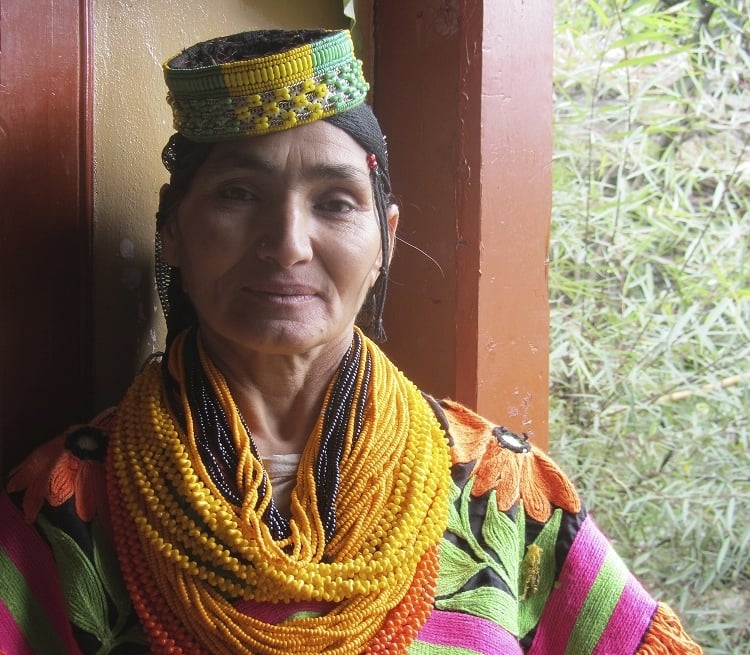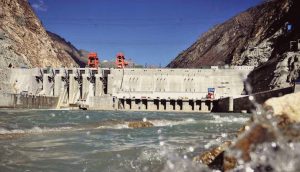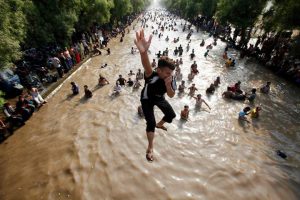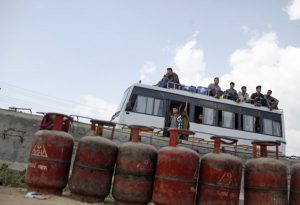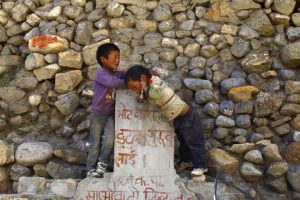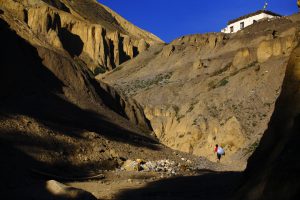The rains started sometime in July and continued for days and weeks, bringing on floods that swept away roads, bridges, agricultural lands and the livelihoods of thousands of people in the high mountains of Pakistan’s Chitral district that houses the three Kalash valleys of Bumburet, Rumbur and Birir.
More than two months on as winter sets in, the signs of destruction from the floods, which killed scores of people in Chitral, are still writ large in Bumburet and Rumbur. The third valley, Birir, was spared.
The three Kalash valleys are encircled by high mountains that separate them from the Afghan province of Nuristan whose people were converted to Islam in the 19th century by an Afghan king.
The Kalash are an ancient tribe, the last survivors of Kafiristan (of which Nuristan in current day Afghanistan was once a part), and their pre-Islamic religion is focused on their environment. Although they worship a creator called Desau, they also believe that trees, stones and streams all have souls.

That reverence for nature has come to nothing it appears. The effects of climate change and rampant deforestation has endangered not just the ancient land but the unique culture and heritage of the Kalash people who can trace their lineage back to Alexander the Great.
“Persistent rainfall accelerated snow melting and triggered both floods and outbursts of glacial lakes in Chitral district,” says Dr Qamar-uz-Zaman Chaudhry, former head of the Pakistan Meteorological Department (PMD) and now a national climate change expert. “This is an El Nino year (a complex series of climatic changes affecting the equatorial Pacific region and beyond every few years) and that contributed to the abruptness of the monsoon this summer. Some monsoon currents penetrated into the Hindu Kush mountain range, an area which generally lies outside the monsoon belt.”
“I would say the floods were a result of all the deforestation that has taken place in these valleys in recent years, just look at the bare mountain sides — and, of course, climate change is also responsible,” added Akram Hussain, a Kalash man who is in charge of the Kalasha Cultural Centre built by the Greek government in 2004 in Bumburet Valley which is thankfully still intact.

Struggling to survive in Bumburet
“You won’t recognise Bumburet Valley when we get there,” said the jeep driver he navigated through streams and attempted to drive over broken roads washed away by the floods in July and August this year.
You need a 4×4 vehicle for the two-hour drive from Chitral town to the Kalash valleys. A narrow jeep track would lead into the narrow valley of Bumburet (the largest of the three valleys) but is now strewn with large boulders brought down by the floods. To get to the villages of Bumburet, you now have to cut through agricultural fields and crisscross the main nullah (watercourse or riverine).
At the entrance to Bumburet Valley lies the flood-damaged government primary school, where children now have to study in tents. The nearby Pakistan Tourism Development Corporation motel is in ruins. The water channel that surrounded it became a raging stream as floodwaters came rushing down the mountains and into the valley.

The rest of the main town was also badly hit. All the big hotels (Bumburet was a popular tourist destination before the floods) were damaged or destroyed as were countless shops, around two dozen houses, many orchards, fields and, of course, the main road itself.
The cultural centre, which houses an impressive museum, community centre and educational facilities for the Kalash people whose women still wear their traditional dress, was spared because of the strong stone walls built around the building by the NGO Greek Volunteers.
The Greek government, which faces severe economic problems and cannot give the Kalash much aid, believes they are descendants of Alexander the Great’s army which marched through the Hindu Kush mountains centuries ago. Indeed, a team of geneticists has found that the Kalash people of Pakistan have DNA from an ancient European population.
Today, only 4,114 Kalash remain according to a July 2014 census. Many have converted to Islam as more outsiders settle into the Kalash Valleys, often building homes near the main road. Around 1,800 Kalash live in Bumburet but higher up on the sides of the valley.
“Our culture was already under threat, and now these floods have destroyed our crops and orchards. We will have to buy food from the bazaar and store it if we are to survive this winter. Luckily, there was no loss of lives in Bumburet because we got a call from the border police which jointly patrols the border with the army. They called us over our mobile phones to warn us that the flood was coming,” said Hussain.
There were, he said, two major floods in Bumburet in July and a smaller one in August. “The second flood in July which lasted for two days caused the most damage. We have never seen floods like this in the Kalash valleys before. I would say that at least half of Bumburet Valley was destroyed or damaged by these floods.”
According to Shaheen Gul, a young Kalash woman in Krakal village in Bumburet, “Our houses are mostly built higher up and all the people living below ran up to our homes. But our fields with corn and beans that were ready for harvest and fruit trees like walnuts and apricots are gone as they were near the nullah.”
The Kalash’s traditional homes are extremely tough and well built and the wooden houses are almost stacked upon one another. “We could hear the flood before it arrived — we were so scared by the roaring sound in the middle of the night. Then the earth started shaking as if there was an earthquake. It was raining very hard that night,” she recalled. “Later, when we came down, we saw all the destruction — these floods were definitely much worse compared to the 2010 floods.”
Melting glaciers
Soldiers patrolling the border with Afghanistan say that melting glaciers also played a role.
“There are around four glaciers high up in these mountains overlooking Bumburet; glacial floods came down along with the rain water that is why there were so many large boulders and we even saw large chunks of black ice,” said Shair Shah, a member of the Chitral Levies border force.
Said Syed Harir Shah, an expert in disaster risk reduction who comes from Chitral, “The shifting of the monsoon further extreme west to Chitral is a highly unusual event. It needs to be researched. How did it shift? Why was no proper warning given to the people of Chitral?”
And in Rumbur Valley
The jeep track to Rumbur Valley, an hour’s drive from the larger Bumburet Valley, is barely open. In fact, the track ends at the entrance to the valley and one has to go on foot to the villages beyond the bridge that somehow survived. “I think there were around 40 to 50 floods here this summer — in 2010 (when there was widespread flooding throughout Pakistan) there was just one big flood,” said Mohammed Iqbal, a Kalash social worker with the Pakistan Red Crescent Society.
“The floods started on July 13 and we had almost continuous flooding until Aug 5. We had rainfall almost every day. There were two types of floods — a glacier flood in the Rumbur Nullah (the mountain stream flowing across the floor of the valley) and flash floods coming down one of the mountain sides,” he added.
The floods brought down boulders, trees and whatever was in their way, destroying orchards, fields, water channels and roads.
A survey of the valley found that 34 houses in Rumbur, mostly near the nullah were damaged or destroyed. There was no loss of life in the valley as the shepherds who take livestock up to the high mountain pastures in the summer months had called on their mobiles to warn the villagers. “The shepherds told us that they saw cloudbursts over the Gangalurat glacier on the boundary with Nuristan which then burst,” said Iqbal.
The Kalash people living further up the valley have to literally cling to the cliff wall above the nullah where they have wedged precarious wooden planks into the cliff side to walk to the main village. There are no big hotels in Rumbur, just a few guesthouses where tourists can stay overnight.
With the road reopening late September, locals say the food crisis is over for now. “We were confined to the houses located further up on the mountain sides and we ran out of food. We had to rely on the army helicopters who dropped wheat and other rations during the floods,” recalled Iqbal.

But the trauma continues.
“The noise of the floods was deafening. The children are still so traumatised. Every time it rains now they start crying and say ‘a flood is coming’,” said Naseem from Grum village at the entrance to the Rumbur Valley.
She is bracing for a long, hard winter. “All our crops with potatoes, beans and sorghum near the nullah are gone along with so many fruit trees. Drinking water supply has not been restored and the women have to daily go down to the nullah to fetch water and carry it up in large vessels; the children and elderly are starting to get water-borne diseases and falling sick. Electricity has not been restored either.”
The community is planning to step in and restore a micro-hydel power plant that provided electricity to Rumbur Valley and was damaged. The main water pipeline was also damaged and people are urging the government to restore it.
“For now, the people who lost their homes are living with relatives but that will put a strain on everyone over the long winter months when the valley is cut off by snow and we can’t buy supplies from the outside,” said Quaid-i-Azam, a Kalash man from Rumbur who works for the Hindu Kush Heights hotel in Chitral town.
The future worries him.
“The floods are becoming worse each year — these floods were much worse than the 2010 flood and the flash floods of 2012. We have to plan now for future floods; we need to stock food in higher places where floods can’t reach and not allow any construction near the nullah.”
“No one is safe now with all this climate change,” he added grimly.
What will happen next year if the heavy rains come again? It’s a question that haunts.

The author was sponsored by a grant from the Earth Journalism Network. An earlier version of this article was first published in Dawn.
